1846 Samuel F. B. Morse Signed Document for US Electro-Magnetic Telegraphs
Lot 69
Categories
Estimate:
$5,000 - $7,000
Absentee vs Live bid
Two ways to bid:
- Leave a max absentee bid and the platform will bid on your behalf up to your maximum bid during the live auction.
- Bid live during the auction and your bids will be submitted real-time to the auctioneer.
Bid Increments
| Price | Bid Increment |
|---|---|
| $0 | $10 |
| $200 | $20 |
| $300 | $25 |
| $500 | $50 |
| $1,000 | $100 |
| $2,000 | $200 |
| $3,000 | $250 |
| $5,000 | $500 |
| $10,000 | $1,000 |
| $20,000 | $2,000 |
| $30,000 | $2,500 |
| $50,000 | $5,000 |
| $100,000 | $10,000 |
| $200,000 | $20,000 |
| $300,000 | $25,000 |
| $500,000 | $50,000 |
About Auction
By Early American History Auctions
Oct 19, 2019
Set Reminder
2019-10-19 12:00:00
2019-10-19 12:00:00
America/New_York
Bidsquare
Bidsquare : Historic Autographs-Currency-Political-Americana-Militaria-Guns
https://www.bidsquare.com/auctions/early-american-history-auctions/historic-autographs-currency-political-americana-militaria-guns-4513
326 Lots of Rare, Historic Autographs, Americana, Civil War Era, George Washington, Abraham Lincoln, Black History, Revolutionary War Era, Colonial America, Federal Period, War of 1812, Colonial Currency, Indian Peace Medals & more... Early American History Auctions auctions@earlyamerican.com
326 Lots of Rare, Historic Autographs, Americana, Civil War Era, George Washington, Abraham Lincoln, Black History, Revolutionary War Era, Colonial America, Federal Period, War of 1812, Colonial Currency, Indian Peace Medals & more... Early American History Auctions auctions@earlyamerican.com
- Lot Description
Autographs
Samuel F. B. Morse 1846 Mexican War Signed Letter
SAMUEL F. B. MORSE (1791-1872). American Painter and Inventor of a single-wire Telegraph System and his "Morse Code."
c. 1846 Mexican-American War Period, Military Message to President Polk, Manuscript Document Telegraph Letter Signed, "Saml. F.B. Morse" as Superintendent of "E. Mag. Telegraphs" for United States, 1 page, measures about 10" x 8" unfolded, Washington, Choice Very Fine. Handwritten on fine quality wove period paper that is lightly folded, very clean and easily readable. Magnetic Telegraph, Baltimore, the Wonderful, extremely sharp and clear rare "E. Mag. Telegraph - BALTIMORE" in Red Oval Hand-stamp. This beautifully written Letter is handwritten and Signed by James E. Stewart, addressed to, "His Excellency James K. Polk, President of the U.S." It reads, in full:
"Sir: - I have 129 men, not equipped, who offer their services to proceed to the Seat of War, on the Southern Frontier. -- Very respectfully - (Signed) James E. Stewart Commanding." Accepted and further Signed, "Washington -- "Saml. F.B. Morse. Superintendent of E. Mag. Telegraphs for U. States."
Captain James E. Stewart's company of Volunteers was raised as one of four Companies in Baltimore, Maryland, two from Baltimore and two from Washington City. These four Companies were designated the "Battalion of Baltimore and Washington Volunteers." They had a reputation for bravery, second to none in the army for discipline and bravery, embarked on the transport steamer "Massachusets" on June 13th, 1846, and on the 16th got underway for the Seat of War.
Polk and sent via an early Electro Magnetic Telegraph and received by Samuel Morse in Washington. Red stamp at top reads, in full: Stamped "E. Mag. Telegraph Baltimore. 11.30 am." This is probably when this Telegraph was sent.
Reverse has noted: "The President of United States / refer letter of Mr. Mura relation to Capt. Stewarts company of Volunteers."Folds, minor soiling.
Samuel F.B. Morse as Inventor, developed the Telegraph system. Morse's system sent out a signal in a series of dots and dashes, each combination representing one letter of the alphabet ("Morse code"). The inventor submitted a patent for his device, which he called "The American Recording Electro-Magnetic Telegraph" in 1837.
In 1838, he sought a congressional appropriation to fund its expansion by performing the first public demonstration of his machine for Congress. Despite an impressive exhibition of the new technology, Morse did not receive the funding he requested until the 27th Congresses (1841-1843).
Once Morse's system was installed in the Capitol, Congress found the telegraph an indispensable tool. At first the telegraph connected only Washington, D.C. and Baltimore, MD; gradually lines were extended to other large east coast cities. With the westward expansion of the country and the addition of new territories to the union, improved communication became a necessity. The telegraph revolutionized the way Congress corresponded with the nation. During the Civil War reports flashed from the battlefields assisted the federal government as it monitored and tracked troop developments. It was the first time that instant battle reports were provided to officials in Washington, D.C. Telegraph lines later linked the Capitol building to the White House and reporters to their respective newspapers.
Read more at: https://books.google.com/books?id=6tF4AAAAMAAJ&pg=PA113&lpg=PA113&dq=Capt.+James+e.+Stewart%E2%80%99s+company+of+Volunteers+1846&source=bl&ots=teMXWH6hK6&sig=s_XWtvDFvc031kLQ583fU2M6RwE&hl=en&sa=X&ved=0ahUKEwjDmomyg__aAhUMKKwKHYASD10Q6AEIOTAC#v=onepage&q&f=false
- Shipping Info
-
Early American provides in-house worldwide shipping. Please contact us directly if you have questions about your specific shipping requirements.
-
- Buyer's Premium



 EUR
EUR CAD
CAD AUD
AUD GBP
GBP MXN
MXN HKD
HKD CNY
CNY MYR
MYR SEK
SEK SGD
SGD CHF
CHF THB
THB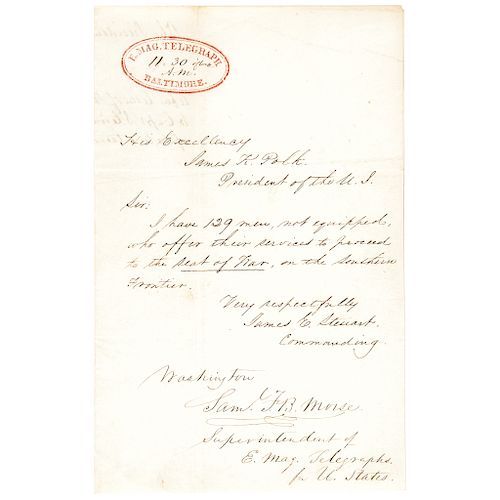

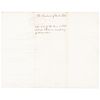
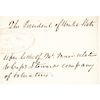
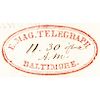

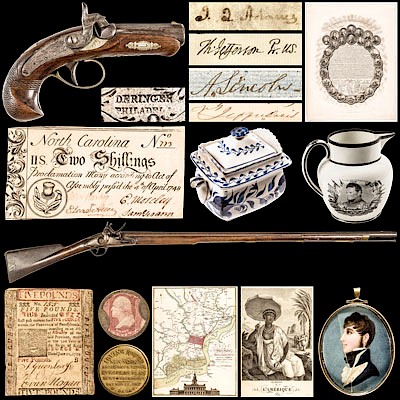





![1667 Land Deed [Massachusetts Bay Colony / Boston] on Parchment](https://s1.img.bidsquare.com/item/m/2949/29492002.jpeg?t=1TIB0e)


